生命末期 TERMINALILLNESS
高中英语单词天天记:illness素材

高中英语单词天天记:· illness· n.['ɪlnəs] ( illnesses )·· 双解释义· C U病,疾病disease; unhealthy state of the body or mind· 基本要点•1.illness是由ill加后缀ness构成的合成词,是“病,疾病”的意思,多指生病的状态。
2.illness强调疾病的种类时,用作可数名词; 表示抽象含义,强调生病的状况时,用作不可数名词。
3.after illness可指“病愈之后”,也可指“生病以后”。
•· 词汇搭配•bear illness 忍受病痛•bring on illness 得病,染病•combat illness 与疾病作斗争•cope with illness 与病魔作斗争•cure illness 治愈疾病•diagnose illness 诊断疾病•drive away illness 战胜疾病•exaggerate illness 夸大病情•feign illness 装病•get over illness 战胜疾病•guard against illness 预防疾病•perish from illness 因病死去•pretend illness 装病•recover from illness 康复•sham illness 装病•suffer from illness 患病•survive illness 幸免死于某种疾病,患病未死•throw off one's illness 摆脱病魔,从病中复原•tide over one's illness 渡过病期的难关•transmit illness to sb 把疾病传染给某人•triumph over illness 战胜疾病•bodily illness 身体有病•brief illness 轻病,小病•dangerous illness 危险的病•deadly illness 绝症,致命的疾病•depressing illness 忧郁症•desperate illness 重病•disabling illness 使人致残的病•exhausting illness 消耗体力的病•fatal illness 致命的疾病,绝症•grave illness 重病•hopeless illness 没有治愈希望的病,不治之症•incurable illness 不治之症•infectious illness 传染病•lingering illness 久病,久治不愈的病•long illness 长期患病•major illness 重病•mental illness 心理病,精神病•prolonged illness 久治不愈的病,慢性病•protracted illness 痼疾•serious illness 重病•short illness 短时间的病,微恙•slight illness 轻病,小病•sudden illness 急病,突发性的病•terminal illness 晚期疾病•untreatable illness 不可治疗的疾病•wearisome illness 令人讨厌的病•after illness 病后•due to illness 因病•in one's illness 在病中•under the cloak of illness 借口生病· 常用短语•diplomatic illness假装生病 feigned illness as an excuse not to do sthThe boss is coming round on an inspection tomorrow.I think I'll have a diplomatic illness and report sick.老板明天要来视察,我想假称有病回避一下。
ICU(英文)
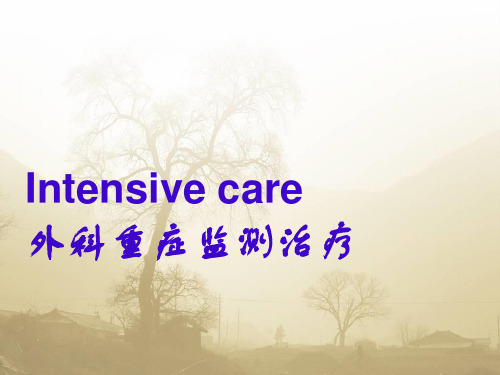
4
Type of ICU patients
Intensive care is usually only offered to those whose condition is potentially reversible and who have a good chance of surviving with intensive care support. Patients requiring intensive care usually require support for hemodynamic instability (hypertension/hypotension) airway or respiratory compromise (such as ventilator support) acute renal failure potentially lethal cardiac dysrhythmias, frequently the cumulative effects of multiple organ system failure
Intensive care 外科重症监测治疗
What is ICU?
An intensive care unit (ICU) is a specially staffed and equipped hospital ward dedicated to the management of patients with lifethreatening illnesses,injuries or complications. 重症监护病房(intensive care unit, ICU)是将 疑难危重患者集中监测治疗的单位。
死亡过程分期探索身体的变化和症状

死亡过程分期探索身体的变化和症状死亡是每个人都无法逃避的最终命运,同时也是一个复杂而神秘的过程。
在这个过程中,人体会经历一系列的变化和症状,我们将在本文中对这些变化和症状进行分期探索。
第一阶段:临终征兆(Pre-Death Phase)在临近死亡之前,患者通常会显示出一些临终征兆。
这些征兆有时被称为“预警信号”,是身体准备迎接死亡的迹象。
其中一些主要的征兆包括:1. 生理和心理变化:患者可能出现心率不稳定、呼吸困难、体温异常以及表情淡漠等变化。
此外,他们可能感到沮丧、焦虑或者情绪低落。
2. 睡眠模式改变:患者可能表现出白天持续的疲劳和夜间失眠。
他们的睡眠质量可能受到影响,导致夜间频繁醒来或者睡眠时间缩短。
3. 食欲减退:患者可能对食物失去兴趣,食欲明显减退。
他们可能拒绝进食或者仅摄入极少量的食物和液体。
第二阶段:临终期(Terminal Phase)当患者进入临终期,死亡的到来变得更加接近。
在这个阶段,患者体内的生理过程逐渐减慢,身体出现更多明显的变化和症状。
以下是临终期的一些典型特征:1. 呼吸困难:患者的呼吸通常会变得不规则且急促,可以出现深呼吸和呼气困难。
这是因为身体逐渐耗尽氧气和能量。
2. 意识混沌:患者可能出现意识模糊、迷茫或者神经功能受损的症状。
他们可能变得困惑、难以理解周围的环境,或者表现出幻觉和妄想等精神状态。
3. 皮肤变化:患者的皮肤可能变得苍白、冷峻或者出现发绀。
这是因为血液循环减慢,氧气供应不足导致的。
4. 尿液减少:患者的尿液量可能明显减少,甚至完全停止排尿。
这是由于肾功能受损和身体液体操控能力下降造成的。
第三阶段:死亡期(Agonal Phase)死亡期是死亡进程的最后阶段,也是最短暂的阶段。
在这个阶段,患者的身体系统逐渐关闭,身体的变化和症状变得更为显著。
以下是死亡期的一些典型特点:1. 呼吸停止:患者的呼吸会逐渐变得浅弱,最终停止。
这标志着生命的最后一刻。
2. 心脏停搏:患者的心脏可能会停止跳动,无法再为身体提供血液和氧气。
病理名词解释(3)
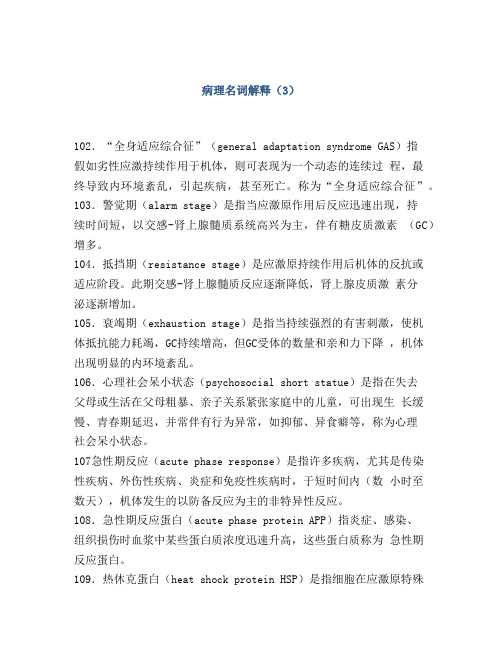
病理名词解释(3)102.“全身适应综合征”(general adaptation syndrome GAS)指假如劣性应激持续作用于机体,则可表现为一个动态的连续过程,最终导致内环境紊乱,引起疾病,甚至死亡。
称为“全身适应综合征”。
103.警觉期(alarm stage)是指当应激原作用后反应迅速出现,持续时间短,以交感-肾上腺髓质系统高兴为主,伴有糖皮质激素(GC)增多。
104.抵挡期(resistance stage)是应激原持续作用后机体的反抗或适应阶段。
此期交感-肾上腺髓质反应逐渐降低,肾上腺皮质激素分泌逐渐增加。
105.衰竭期(exhaustion stage)是指当持续强烈的有害刺激,使机体抵抗能力耗竭,GC持续增高,但GC受体的数量和亲和力下降,机体出现明显的内环境紊乱。
106.心理社会呆小状态(psychosocial short statue)是指在失去父母或生活在父母粗暴、亲子关系紧张家庭中的儿童,可出现生长缓慢、青春期延迟,并常伴有行为异常,如抑郁、异食癖等,称为心理社会呆小状态。
107急性期反应(acute phase response)是指许多疾病,尤其是传染性疾病、外伤性疾病、炎症和免疫性疾病时,于短时间内(数小时至数天),机体发生的以防备反应为主的非特异性反应。
108.急性期反应蛋白(acute phase protein APP)指炎症、感染、组织损伤时血浆中某些蛋白质浓度迅速升高,这些蛋白质称为急性期反应蛋白。
109.热休克蛋白(heat shock protein HSP)是指细胞在应激原特殊是环境高温诱导下所生成的一组蛋白质。
110.热休克蛋白的“分子伴娘”(molecular chaperone)指热休克蛋白中大多数是细胞的结构蛋白(称为结构性HSP),其主要功能是帮助蛋白质进行准确的折叠、移位、维持以及降解,因此被称为“分子伴娘”。
111.应激性高血糖或应激性糖尿:应激时,胰岛素的相对不足和外周胰岛素依赖组织对胰岛素的敏感性降低,机体对葡萄糖的利用减少(胰岛素耐受);儿茶酚胺、胰高血糖素、生长激素、肾上腺糖皮质激素等促进糖原分解和糖原异生,主要表现为高血糖,甚至可以超过葡萄糖的肾糖阈8.96mmol/L(160mg/dl)而出现糖尿,称为应激性高血糖或应激性糖尿。
护理学基础的重点名词解释
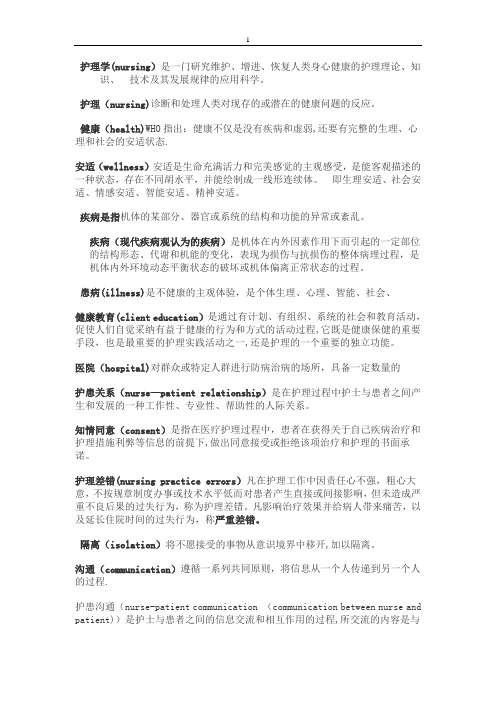
护理学(nursing)是一门研究维护、增进、恢复人类身心健康的护理理论、知识、技术及其发展规律的应用科学。
护理(nursing)诊断和处理人类对现存的或潜在的健康问题的反应。
健康(health)WHO指出:健康不仅是没有疾病和虚弱,还要有完整的生理、心理和社会的安适状态.安适(wellness)安适是生命充满活力和完美感觉的主观感受,是能客观描述的一种状态,存在不同胡水平,并能绘制成一线形连续体。
即生理安适、社会安适、情感安适、智能安适、精神安适。
疾病是指机体的某部分、器官或系统的结构和功能的异常或紊乱。
疾病(现代疾病观认为的疾病)是机体在内外因素作用下而引起的一定部位的结构形态、代谢和机能的变化,表现为损伤与抗损伤的整体病理过程,是机体内外环境动态平衡状态的破坏或机体偏离正常状态的过程。
患病(illness)是不健康的主观体验,是个体生理、心理、智能、社会、健康教育(client education)是通过有计划、有组织、系统的社会和教育活动,促使人们自觉采纳有益于健康的行为和方式的活动过程,它既是健康保健的重要手段,也是最重要的护理实践活动之一,还是护理的一个重要的独立功能。
医院(hospital)对群众或特定人群进行防病治病的场所,具备一定数量的护患关系(nurse—patient relationship)是在护理过程中护士与患者之间产生和发展的一种工作性、专业性、帮助性的人际关系。
知情同意(consent)是指在医疗护理过程中,患者在获得关于自己疾病治疗和护理措施利弊等信息的前提下,做出同意接受或拒绝该项治疗和护理的书面承诺。
护理差错(nursing practice errors)凡在护理工作中因责任心不强,粗心大意,不按规章制度办事或技术水平低而对患者产生直接或间接影响,但未造成严重不良后果的过失行为,称为护理差错。
凡影响治疗效果并给病人带来痛苦,以及延长住院时间的过失行为,称严重差错。
五个愿望
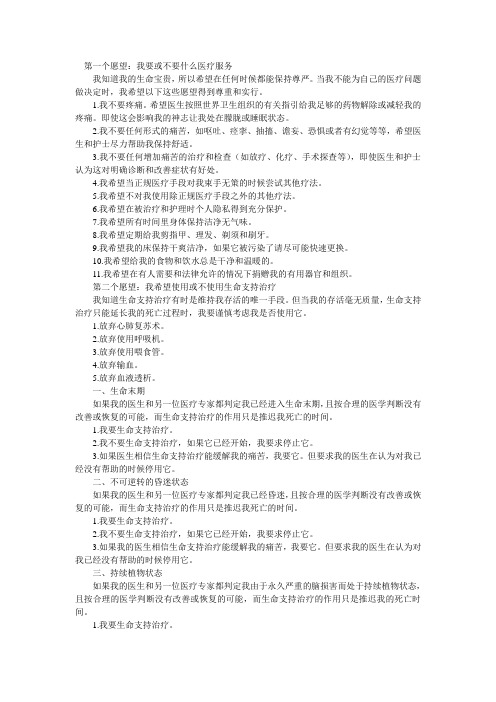
第一个愿望:我要或不要什么医疗服务我知道我的生命宝贵,所以希望在任何时候都能保持尊严。
当我不能为自己的医疗问题做决定时,我希望以下这些愿望得到尊重和实行。
1.我不要疼痛。
希望医生按照世界卫生组织的有关指引给我足够的药物解除或减轻我的疼痛。
即使这会影响我的神志让我处在朦胧或睡眠状态。
2.我不要任何形式的痛苦,如呕吐、痉挛、抽搐、谵妄、恐惧或者有幻觉等等,希望医生和护士尽力帮助我保持舒适。
3.我不要任何增加痛苦的治疗和检查(如放疗、化疗、手术探查等),即使医生和护士认为这对明确诊断和改善症状有好处。
4.我希望当正规医疗手段对我束手无策的时候尝试其他疗法。
5.我希望不对我使用除正规医疗手段之外的其他疗法。
6.我希望在被治疗和护理时个人隐私得到充分保护。
7.我希望所有时间里身体保持洁净无气味。
8.我希望定期给我剪指甲、理发、剃须和刷牙。
9.我希望我的床保持干爽洁净,如果它被污染了请尽可能快速更换。
10.我希望给我的食物和饮水总是干净和温暖的。
11.我希望在有人需要和法律允许的情况下捐赠我的有用器官和组织。
第二个愿望:我希望使用或不使用生命支持治疗我知道生命支持治疗有时是维持我存活的唯一手段。
但当我的存活毫无质量,生命支持治疗只能延长我的死亡过程时,我要谨慎考虑我是否使用它。
1.放弃心肺复苏术。
2.放弃使用呼吸机。
3.放弃使用喂食管。
4.放弃输血。
5.放弃血液透析。
一、生命末期如果我的医生和另一位医疗专家都判定我已经进入生命末期,且按合理的医学判断没有改善或恢复的可能,而生命支持治疗的作用只是推迟我死亡的时间。
1.我要生命支持治疗。
2.我不要生命支持治疗,如果它已经开始,我要求停止它。
3.如果医生相信生命支持治疗能缓解我的痛苦,我要它。
但要求我的医生在认为对我已经没有帮助的时候停用它。
二、不可逆转的昏迷状态如果我的医生和另一位医疗专家都判定我已经昏迷,且按合理的医学判断没有改善或恢复的可能,而生命支持治疗的作用只是推迟我死亡的时间。
关于英语朗读短文一分钟
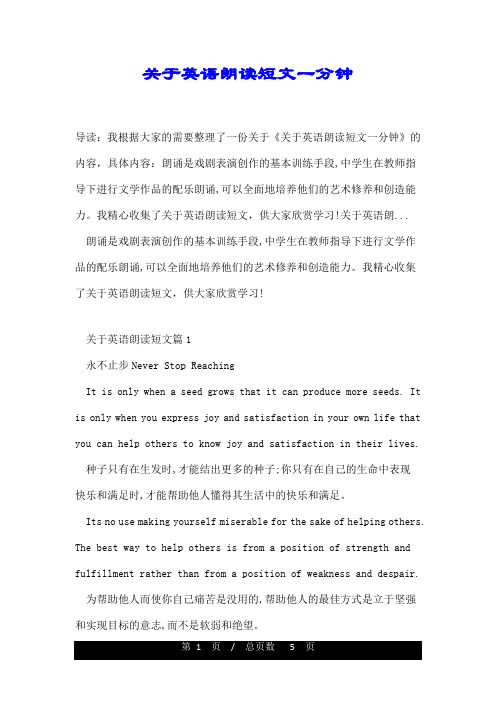
关于英语朗读短文一分钟导读:我根据大家的需要整理了一份关于《关于英语朗读短文一分钟》的内容,具体内容:朗诵是戏剧表演创作的基本训练手段,中学生在教师指导下进行文学作品的配乐朗诵,可以全面地培养他们的艺术修养和创造能力。
我精心收集了关于英语朗读短文,供大家欣赏学习!关于英语朗...朗诵是戏剧表演创作的基本训练手段,中学生在教师指导下进行文学作品的配乐朗诵,可以全面地培养他们的艺术修养和创造能力。
我精心收集了关于英语朗读短文,供大家欣赏学习!关于英语朗读短文篇1永不止步Never Stop ReachingIt is only when a seed grows that it can produce more seeds. It is only when you express joy and satisfaction in your own life that you can help others to know joy and satisfaction in their lives.种子只有在生发时,才能结出更多的种子;你只有在自己的生命中表现快乐和满足时,才能帮助他人懂得其生活中的快乐和满足。
Its no use making yourself miserable for the sake of helping others. The best way to help others is from a position of strength and fulfillment rather than from a position of weakness and despair.为帮助他人而使你自己痛苦是没用的,帮助他人的最佳方式是立于坚强和实现目标的意志,而不是软弱和绝望。
The goals, dreams and desires you have are yours for a reason. They are there to show you and force you to make the most of your life.你的目标、梦想和愿望理应属于你,它们的存在告诉并且敦促你充分把握利用好自己的生命。
终末期肾病

终末期肾病
终末期肾病(End-stage renal disease,缩写为ESRD)是
指肾功能失代偿时,肾脏不能正常地清除体内代谢产物和多余的水分,同时也不能维持体内电解质的平衡。
常见的症状包括体重下降、贫血、高血压、骨质疏松等,甚至可能引发心血管疾病、肝脏、神经系统和心脏等部位的病变。
终末期肾病通常是由于其他肾脏疾病的恶化而导致,例如糖尿病、高血压、肾小球肾炎等。
如果肾功能无法通过药物治疗和生活方式调节得以缓解,患者可能需要进行肾透析或肾移植等治疗方式。
肾透析是通过人工方法清除血液中的多余水分和废物,用来替代失去功能的肾脏。
肾移植则是将正常的肾脏植入患者的体内,用来代替不再有效的肾脏。
总体而言,终末期肾病是一种影响生命质量和寿命的严重疾病,需要及时治疗和管理。
TED英语演讲:在死亡面前,生活如何有意义
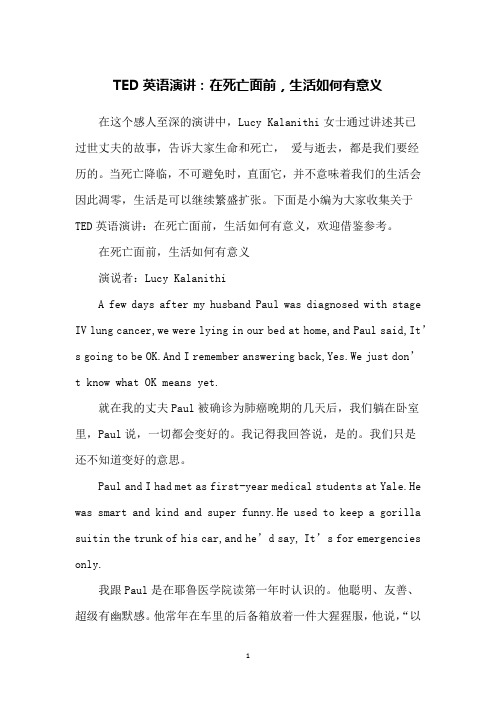
TED英语演讲:在死亡面前,生活如何有意义在这个感人至深的演讲中,Lucy Kalanithi女士通过讲述其已过世丈夫的故事,告诉大家生命和死亡,爱与逝去,都是我们要经历的。
当死亡降临,不可避免时,直面它,并不意味着我们的生活会因此凋零,生活是可以继续繁盛扩张。
下面是小编为大家收集关于TED英语演讲:在死亡面前,生活如何有意义,欢迎借鉴参考。
在死亡面前,生活如何有意义演说者:Lucy KalanithiA few days after my husband Paul was diagnosed with stage IV lung cancer,we were lying in our bed at home,and Paul said,It’s going to be OK.And I remember answering back,Yes.We just don’t know what OK means yet.就在我的丈夫Paul被确诊为肺癌晚期的几天后,我们躺在卧室里,Paul说,一切都会变好的。
我记得我回答说,是的。
我们只是还不知道变好的意思。
Paul and I had met as first-year medical students at Yale.He was smart and kind and super funny.He used to keep a gorilla suitin the trunk of his car,and he’d say, It’s for emergencies only.我跟Paul是在耶鲁医学院读第一年时认识的。
他聪明、友善、超级有幽默感。
他常年在车里的后备箱放着一件大猩猩服,他说,“以备不时之需。
”I fell in love with Paul as I watched the care he took with his patients.He stayed late talking with them,seeking to understand the experience of illnessand not just its technicalities.He later told me he fell in love with mewhen he saw me cry over an EKG of a heart that had ceased beating.We didn’t know it yet,but even in the heady days of young love,we were learning how to approach suffering together.我在目睹了他细心照顾他的患者之后便爱上了他。
晚期疾病的心理适应
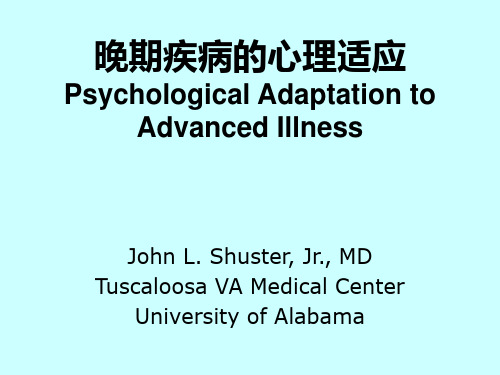
Loss of Morale, Meaning Loss of Will to Live
生命末期精神疾病的范围
无望 恐慌” “恐慌” 厌倦 疲劳性疾病谱 丧失尊严 躯体痛苦的表现 Range of Psychiatric Problems at Life’s End
Hopelessness “Tailspin” Boredom Fatigue spectrum problems Loss of Dignity Manifestations of Physical Distress
Underestimation of the effectiveness of available treatments.
Therapeutic nihilism
Stigma attached to psychiatric illness
Psychiatric evaluations also stigmatized
终末期疾病的精神病学并发症
常见 终末期疾病中未被识别和治疗 增加痛苦
患者 亲属
对治疗有反应
Psychiatric Complications of Terminal Illness Common Underrecognized and Undertreated in Terminal Illness Add to Suffering Patients Families Respond to Treatment
Suffering Hopelessness Dignity Meaning Burden of Multiple Symptoms
癌症的的精神疾病谱Spectrum of
Psychiatric Disorders in Cancer
肺和胃肠道症状:在生命的尽头的普通物理症状
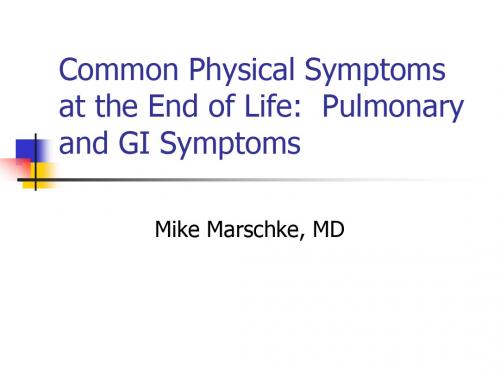
Dry Mouth
Hyposalivation
Mouth care and gum/candy, popsicles Artificial saliva Oral swabs/wash cloth
ucositis
Diphenhydramine, dexamethasone, lidocaine, and nystatin swish and swallow
4 Weeks Later in Hospice
More dyspneic and semi-comatose Lots of upper airway noise with
wheezes more prevalent Gets agitated at times, cyanotic Difficult swallowing pills At times when sleeping family feels he
Common Physical Symptoms at the End of Life: Pulmonary and GI Symptoms
Mike Marschke, MD
Mr. M - Chronic Smoker
Mr. M, 78 YO, is a lifetime smoker. Dyspnea began 5 years ago.
Measurements?
pO2, pCO2, O2 sats Peak flows Pulmonary function tests measuring lung
volumes and flow Prognosis < 6 mos. : Class IV respiratory failure (= dyspnea at rest) Frequent ER/hospital stays, recurring
电影《第二十条》作文素材
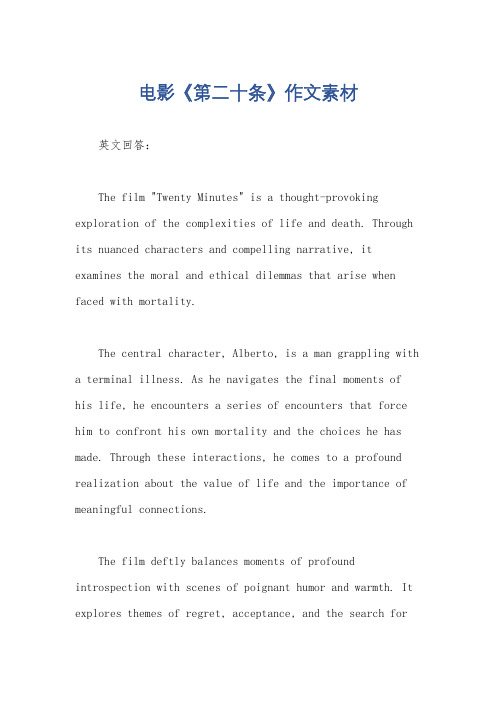
电影《第二十条》作文素材英文回答:The film "Twenty Minutes" is a thought-provoking exploration of the complexities of life and death. Through its nuanced characters and compelling narrative, it examines the moral and ethical dilemmas that arise when faced with mortality.The central character, Alberto, is a man grappling with a terminal illness. As he navigates the final moments of his life, he encounters a series of encounters that force him to confront his own mortality and the choices he has made. Through these interactions, he comes to a profound realization about the value of life and the importance of meaningful connections.The film deftly balances moments of profound introspection with scenes of poignant humor and warmth. It explores themes of regret, acceptance, and the search forredemption. Through Alberto's journey, we are reminded of the fragility of life and the need to make the most of every moment.The cinematography and score are equally powerful, creating an immersive experience that complements the emotional depth of the story. The acting is superb, with each performer delivering nuanced and believable performances.Overall, "Twenty Minutes" is an unforgettable film that resonates long after the credits roll. It is a testament to the human spirit and the power of connection, reminding us that even in the face of death, there is always something to be gained.中文回答:电影《第二十条》观后感。
末端病的名词解释
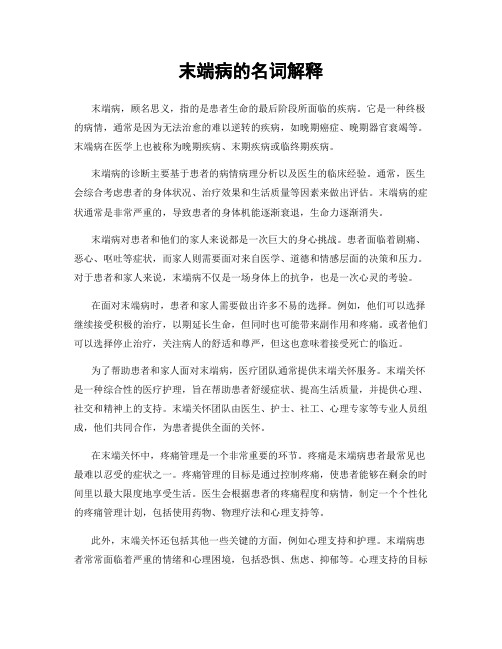
末端病的名词解释末端病,顾名思义,指的是患者生命的最后阶段所面临的疾病。
它是一种终极的病情,通常是因为无法治愈的难以逆转的疾病,如晚期癌症、晚期器官衰竭等。
末端病在医学上也被称为晚期疾病、末期疾病或临终期疾病。
末端病的诊断主要基于患者的病情病理分析以及医生的临床经验。
通常,医生会综合考虑患者的身体状况、治疗效果和生活质量等因素来做出评估。
末端病的症状通常是非常严重的,导致患者的身体机能逐渐衰退,生命力逐渐消失。
末端病对患者和他们的家人来说都是一次巨大的身心挑战。
患者面临着剧痛、恶心、呕吐等症状,而家人则需要面对来自医学、道德和情感层面的决策和压力。
对于患者和家人来说,末端病不仅是一场身体上的抗争,也是一次心灵的考验。
在面对末端病时,患者和家人需要做出许多不易的选择。
例如,他们可以选择继续接受积极的治疗,以期延长生命,但同时也可能带来副作用和疼痛。
或者他们可以选择停止治疗,关注病人的舒适和尊严,但这也意味着接受死亡的临近。
为了帮助患者和家人面对末端病,医疗团队通常提供末端关怀服务。
末端关怀是一种综合性的医疗护理,旨在帮助患者舒缓症状、提高生活质量,并提供心理、社交和精神上的支持。
末端关怀团队由医生、护士、社工、心理专家等专业人员组成,他们共同合作,为患者提供全面的关怀。
在末端关怀中,疼痛管理是一个非常重要的环节。
疼痛是末端病患者最常见也最难以忍受的症状之一。
疼痛管理的目标是通过控制疼痛,使患者能够在剩余的时间里以最大限度地享受生活。
医生会根据患者的疼痛程度和病情,制定一个个性化的疼痛管理计划,包括使用药物、物理疗法和心理支持等。
此外,末端关怀还包括其他一些关键的方面,例如心理支持和护理。
末端病患者常常面临着严重的情绪和心理困境,包括恐惧、焦虑、抑郁等。
心理支持的目标是帮助患者和家人应对这些困境,提供情绪和心理的支持。
护理方面,末端关怀着重强调对患者的日常护理,包括适当的营养、定期换位和身体清洁等。
生命为主题的作文高中生-英语中文互译
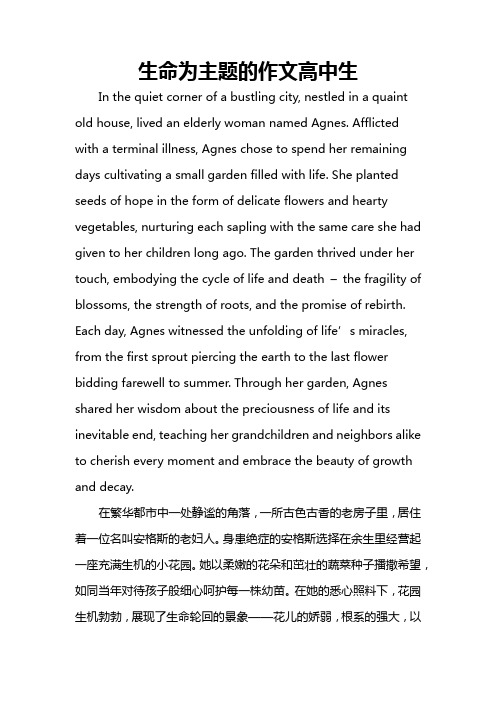
生命为主题的作文高中生In the quiet corner of a bustling city, nestled in a quaint old house, lived an elderly woman named Agnes. Afflicted with a terminal illness, Agnes chose to spend her remaining days cultivating a small garden filled with life. She planted seeds of hope in the form of delicate flowers and hearty vegetables, nurturing each sapling with the same care she had given to her children long ago. The garden thrived under her touch, embodying the cycle of life and death –the fragility of blossoms, the strength of roots, and the promise of rebirth. Each day, Agnes witnessed the unfolding of life’s miracles, from the first sprout piercing the earth to the last flower bidding farewell to summer. Through her garden, Agnes shared her wisdom about the preciousness of life and its inevitable end, teaching her grandchildren and neighbors alike to cherish every moment and embrace the beauty of growth and decay.在繁华都市中一处静谧的角落,一所古色古香的老房子里,居住着一位名叫安格斯的老妇人。
英文terminal的中文是什么意思
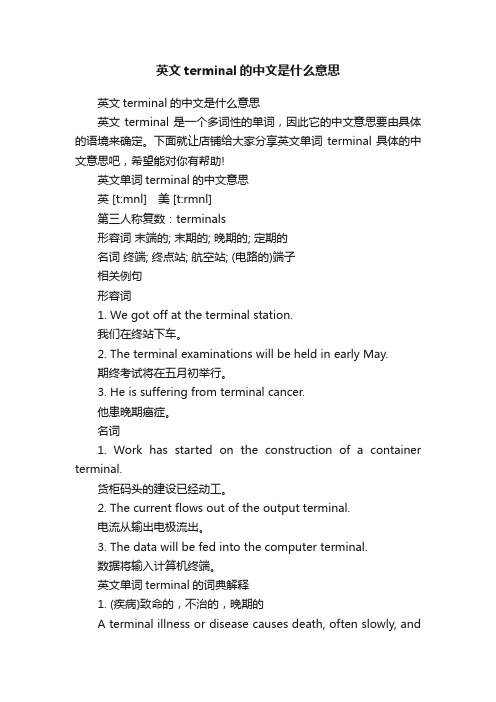
英文terminal的中文是什么意思英文terminal的中文是什么意思英文terminal是一个多词性的单词,因此它的中文意思要由具体的语境来确定。
下面就让店铺给大家分享英文单词terminal具体的中文意思吧,希望能对你有帮助!英文单词terminal的中文意思英 [t:mnl] 美 [t:rmnl]第三人称复数:terminals形容词末端的; 末期的; 晚期的; 定期的名词终端; 终点站; 航空站; (电路的)端子相关例句形容词1. We got off at the terminal station.我们在终站下车。
2. The terminal examinations will be held in early May.期终考试将在五月初举行。
3. He is suffering from terminal cancer.他患晚期癌症。
名词1. Work has started on the construction of a container terminal.货柜码头的建设已经动工。
2. The current flows out of the output terminal.电流从输出电极流出。
3. The data will be fed into the computer terminal.数据将输入计算机终端。
英文单词terminal的词典解释1. (疾病)致命的,不治的,晚期的A terminal illness or disease causes death, often slowly, andcannot be cured.e.g. ...terminal cancer.晚期癌症e.g. ...his illness was terminal.他的病没治了。
2. (病人)患绝症的,晚期的,病危的A terminal patient is dying of a terminal illness or disease.e.g. They have started a hospice for terminal patients.他们为身患绝症的病人开办了一个安养所。
姑息治疗 英语作文
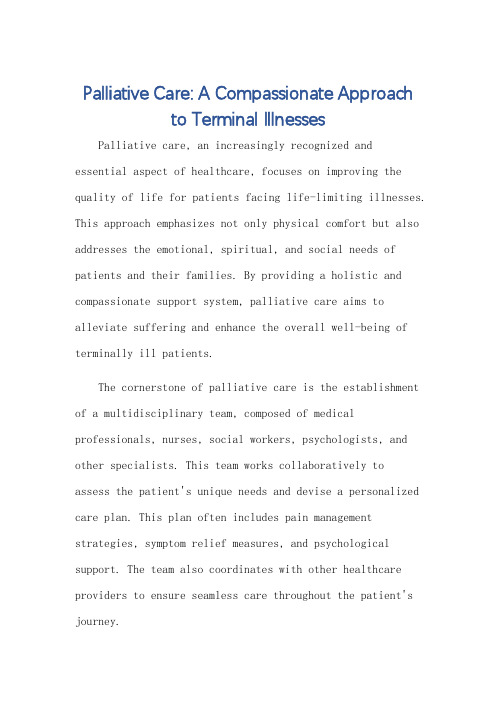
Palliative Care: A Compassionate Approachto Terminal IllnessesPalliative care, an increasingly recognized andessential aspect of healthcare, focuses on improving the quality of life for patients facing life-limiting illnesses. This approach emphasizes not only physical comfort but also addresses the emotional, spiritual, and social needs of patients and their families. By providing a holistic and compassionate support system, palliative care aims to alleviate suffering and enhance the overall well-being of terminally ill patients.The cornerstone of palliative care is the establishment of a multidisciplinary team, composed of medical professionals, nurses, social workers, psychologists, and other specialists. This team works collaboratively toassess the patient's unique needs and devise a personalized care plan. This plan often includes pain management strategies, symptom relief measures, and psychological support. The team also coordinates with other healthcare providers to ensure seamless care throughout the patient's journey.One significant aspect of palliative care is the emphasis on communication. Effective communication between healthcare providers and patients is crucial for understanding the patient's preferences, fears, and expectations. It also allows for the establishment of trust and a sense of partnership in the care process. Bylistening attentively and responding empathetically, healthcare providers can help patients feel more comfortable and less anxious about their condition.Moreover, palliative care recognizes the importance of involving family members in the care process. Families often play a pivotal role in providing emotional support and caregiving. Palliative care teams work closely with families to educate them about the patient's condition, treatment options, and expected outcomes. This education helps families to cope with the emotional stress of caring for a terminally ill loved one and to make informed decisions about the patient's care.Another key aspect of palliative care is the focus on spiritual and existential needs. For many patients, facing a terminal illness can trigger deep questions about themeaning of life and the afterlife. Palliative care providers are trained to address these concerns and to connect patients with spiritual resources that may provide comfort and solace.Furthermore, palliative care also aims to improve the patient's quality of life by promoting activities that bring joy and fulfillment. This may include participating in hobbies, spending time with loved ones, or simply enjoying the pleasures of daily life. By focusing on these aspects of well-being, palliative care helps patients to maintain a sense of dignity and purpose even in the face of terminal illness.In conclusion, palliative care represents a compassionate and holistic approach to caring forterminally ill patients. It addresses not only the physical symptoms of the disease but also the emotional, social, and spiritual needs of patients and their families. By providing a comprehensive support system, palliative care can significantly improve the quality of life for those facing the end of their lives.**姑息治疗:临终疾病的人性化护理方法**姑息治疗作为一种日益受到认可和至关重要的医疗护理方式,其重点在于改善面临生命末期疾病患者的生活质量。
OSDFSTTPPFSTTF的区别
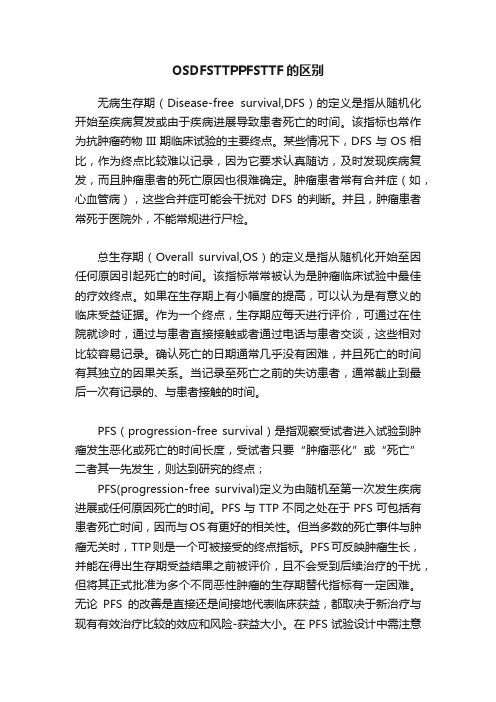
OSDFSTTPPFSTTF的区别无病生存期(Disease-free survival,DFS)的定义是指从随机化开始至疾病复发或由于疾病进展导致患者死亡的时间。
该指标也常作为抗肿瘤药物III期临床试验的主要终点。
某些情况下,DFS与OS相比,作为终点比较难以记录,因为它要求认真随访,及时发现疾病复发,而且肿瘤患者的死亡原因也很难确定。
肿瘤患者常有合并症(如,心血管病),这些合并症可能会干扰对DFS的判断。
并且,肿瘤患者常死于医院外,不能常规进行尸检。
总生存期(Overall survival,OS)的定义是指从随机化开始至因任何原因引起死亡的时间。
该指标常常被认为是肿瘤临床试验中最佳的疗效终点。
如果在生存期上有小幅度的提高,可以认为是有意义的临床受益证据。
作为一个终点,生存期应每天进行评价,可通过在住院就诊时,通过与患者直接接触或者通过电话与患者交谈,这些相对比较容易记录。
确认死亡的日期通常几乎没有困难,并且死亡的时间有其独立的因果关系。
当记录至死亡之前的失访患者,通常截止到最后一次有记录的、与患者接触的时间。
PFS(progression-free survival)是指观察受试者进入试验到肿瘤发生恶化或死亡的时间长度,受试者只要“肿瘤恶化”或“死亡”二者其一先发生,则达到研究的终点;PFS(progression-free survival)定义为由随机至第一次发生疾病进展或任何原因死亡的时间。
PFS与TTP不同之处在于PFS可包括有患者死亡时间,因而与OS有更好的相关性。
但当多数的死亡事件与肿瘤无关时,TTP则是一个可被接受的终点指标。
PFS可反映肿瘤生长,并能在得出生存期受益结果之前被评价,且不会受到后续治疗的干扰,但将其正式批准为多个不同恶性肿瘤的生存期替代指标有一定困难。
无论PFS的改善是直接还是间接地代表临床获益,都取决于新治疗与现有有效治疗比较的效应和风险-获益大小。
在PFS试验设计中需注意详细规定对PFS的评估、观察和分析方法,并仔细确定好肿瘤进展的标准,盲法在其整个试验执行过程中非常重要,最好应有一个由影像学家和临床专家组成的独立评估小组进行。
ICU(英文)

APACHE
William Knaus Initially 34 physiological variables 1985 – APACHE II 12 variables APACHE II allows probability of death before hospital discharge to be estimated Standardised mortality ratio
5
Type of ICU patients
Terminal illness or irreversible Terminal cancer Permanent brain damage
Infectious disease? SARS√ --management of mechanically ventilated severe acute respiratory syndrome (SARS) patients in the isolation intensive care unit (ICU)--successful
17 ICU?
monitoring ECG heart rate, rhythm, ischemia Blood pressure non-invasive invasive arterial,central venous, pulmonary artery Hemodynamic measurement
Intensive care 外科重症监测治疗
What is ICU?
An intensive care unit (ICU) is a specially staffed and equipped hospital ward dedicated to the management of patients with lifethreatening illnesses,injuries or complications. 重症监护病房(intensive care unit, ICU)是将 疑难危重患者集中监测治疗的单位。
